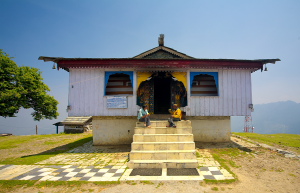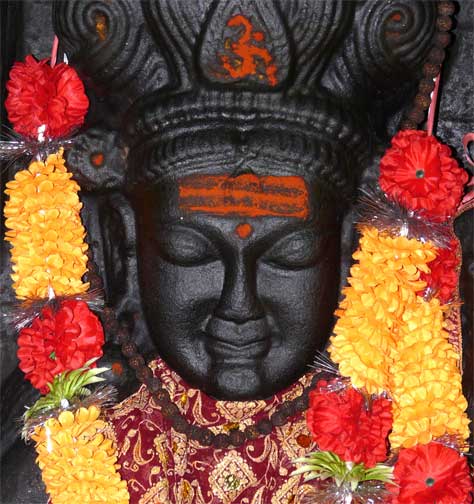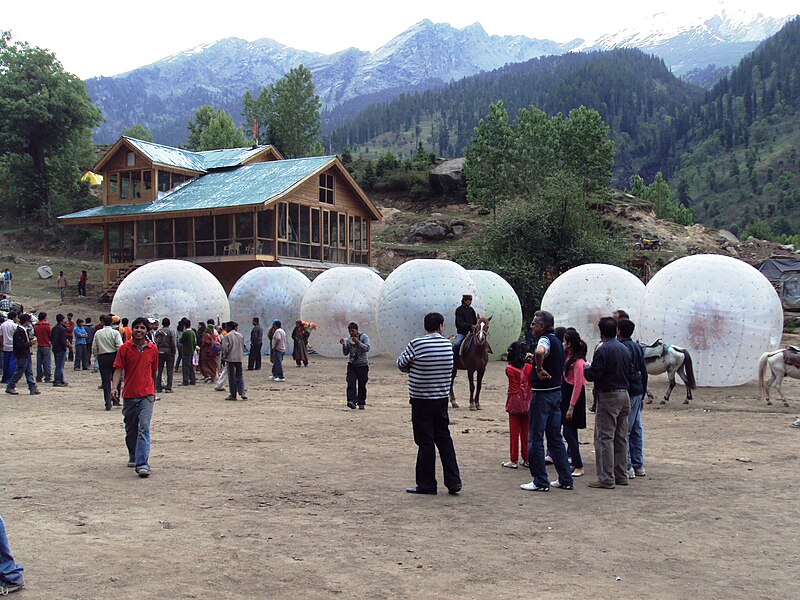The town of Kullu, positioned in the charming Kullu valley in the state of Himachal Pradesh and nestled amid lower Himalayas, is primarily famous for its breathtaking natural beauty, sprawling spans of lush valleys and mountains. It is also renowned for its apple orchards, temples.Kullu was once known as Kulanthapitha - the end of the habitable world.Kullu got its first motorable access only after independence. The long centuries of seclusion have however allowed the area to retain a considerable measures of its traditional charm. Here is the core of an intricate web of numerous valleys, each of which is a visual delight and seems more beautiful than the other.The Silver Valley has nature's treasures that lie carelessly scattered as flowers. This wealth nestles by every tree in the splendid forests. There is pleasure in every step you take in these enchanted valleys and in every gurgle you hear in the clear mountain streams.
How to reach here:
By Air: The airport at Bhunter is 10 km from Kullu.
By Rail : Jogindernagar is the nearest railhead to Kullu, which is at a distance of 125 km. This railway station is connected to all Indian cities via Chandigarh which is 270 km away from Kullu.
Another railway station is Kandrori (KNDI) which is 76 kms away from Kullu.
Best time to visit: April to September.
Languages spoken: Pahari, Hindi and English.
Must eat: Sidu, Patande, Meat.
Famous Restaurants: Satyam, Mayur, Gozy.
Places you must visit:
Raghunath Temple worships Lord Ram, who is believed as one of the most important deities in the Hindu mythology and is the patron deity amongst the residents of Kullu valley. It was erected in the year 1660 by Raja Jagat Singh, the one-time ruler of Kullu, basically to make amends for his sins. He got an idol of Lord Ram from Ayodhya and founded it in this temple.

Bijli Mahadev Temple is placed on a spur at an elevation of 2460 meters. As the name suggests, the temple is frequently struck by lightning (bijli, lightning). From the temple a panoramic view of Kulu and Paravati valleys can be seen. A 60 feet high staff of Bijli Mahadev temple glistens like a silver needle in the sun. In this temple of lightening it is said, the tall staff attracts the divine blessings in the form of lightening. The rest of the story can be heard from the priest, which is un-believable but true.


Jagannathi Devi Temple (Bekhli Temple):This temple is believed to have been constructed 1500 years ago. The deity in the temple is also known as Bhuweneshawari, who is considered as the sister of Lord Vishnu. The walls of the temple are carved with the images of Durga and the temple as such reflects the local architecture. this beautiful shrine is also linked with a legend. It is said that once a shepherd boy accidentally noticed that two girls danced to the tune of his magical flute and he caught hold of one among them. The goddess revealed her identity and agreed to settle in the village at Bekhli.

Chandrakhani Pass is located in the Parbati valley that joins Malana Valley to Kullu Valley. An ideal base for trekking, the pass is known for its scenic beauty. Chandrakhani is 3600m above sea level and offers scenic trekking trails.

Pandoh dam is a power generator hydro-electric dam, built on river Beas. The lake is the reservoir of the dam and has five bays that regulate the water. At a height of 76 m, the dam is earth cum rock filled and is part of the Bhakra Beas Management Board. This dam is en route to Manali from Kullu and tourists can stop over here to capture a few glimpses of this magnanimous beauty in their cameras.

Great Himalayan National Park, also known as Jawahar Lal Nehru Great Himalayan National Park, is an ideal place for wildlife buffs. Located amidst the spectacular natural vista, the park is home to some of the most elusive and endangered species of animals. Sprawling on an area of 50 sqkm, there are around 180 species of bird and mammals that tourists can sight here. Some of the most popular animals tourist can look forward to sights include musk deer, brown bears, Himalayan Tahr, Ibex, black bears and rare species of snow leopard. The best way to explore the park is by taking up a five day trek that is organized by the park authorities.

Hanogi Mata Temple is a popular temple attraction. Dedicated to Hango Mata, this Hindu temple is visited by devotees all the year round. Located atop a small peak, green mountains serve as a backdrop for the temple and a gleaming stream flowing below makes this temple a stunning attraction.

Manikaran is associated with Lord Shiva and his divine consort, Parbati, who lost and recovered her ear rings here. Legend has it that once when Shiva and Parbati were relaxing by the river. Parbati's ear rings fell nto the water. The lord of another world ( Patal Nagari ) named Shesh Nag took possession of them and despite Parvati's pleas, he refused to hand them back. However when all the gods prevailed upon him, he snorted them out of his nostrils, causing a boiling fountain of water to erupt. the jewels thus returned. There are temples of Ramchandra and Shiva besides the Gurudwara. This place is famous for hot water springs. Thousands of people take a dip in its hot water. The main water is so hot that Dal ( pulses ), Rice, Vegetables etc. can be boiled in it.

Pulga and Kheerganga: a stiff march takes one to restful environment affords a Sylvan and peaceful retreat for body and mind. The 'Tos Nullah' which branches off from the main Parbati valley is well worth exploration by those who favour the wilder aspects of natural scenery are prepared to camp out. Kirganga lies 10 km. from Pulga. Khirganga is also famous for hot springs.

Katrain is situated on the way to Manali and has acquired prominence due to apple orchards, a fruit research station and trout hatchery. It is also famous for bee keeping and Govt. trout farm at Patilkulh.

Naggar was the capital of the Kullu Rajas for about 1,400 years. It is also known for its castle and the Nicholas Roerich's Museum. On the left bank of the river Beas and about three hundred metres above the river, Naggar is delightfully situated on the wooded slope and commands an extensive view, especially of the North-West of the valley. There are a large number of famous temples in and around Naggar and an excellent place for a longer stay.

Largi is a small hamlet providing excellent trout fishing. The famous rivers Sainj and Tirthan join the Beas a few hundred metres below. Larji is patronised mostly by anglers.

Malana is a tiny village which lies a little ahead of the 'Chanderkhani Pass' famous for the temple of 'Jamlu'. Malana village is reputed to be the oldest democracy in the world in existence where all the inhabitants of the village take part in managing its affairs. It is also famous for trekking.

Kasol is charmingly located in an open space which slopes down to a broad expanse of clear white sand at the edge of the river. It is situated on the bank of Parbati river in the Parbati valley.

Kaisdhar is a high meadow fringed by deodar trees. A picturesque spot.

Jagatipatt Temple is a small square structure which contains "Jagtipatt" a slab of stone measuring 5'x8'x6" which is said to have been brought from a place near Vashisht by honey bee. This is also place for meeting of local deities of Kullu.

Tripura Sundari Temple: This pagoda shaped wooden temple is situated in the upper part of the Naggar village. This is also a rare examples of architecture.

Tripurasundari Vijaya Sthava
[Ode of Victory to Tripurasundari]
Lakshya bhakthi rasardhra hruthsarasije sadbhi sadaradhitha|
Sandrananda mayi sudhakara kala gandojjwalanmoulike||
Sarvani sarana gatharthi samani sachinmayee sarvadha|
Srichakradhi nivasini, vijayathe Srirajarajeswari|| 14
Victory to the Goddess who resides in the center of the Sri Chakra, who lives among those hearts drenched in devotion towards her. She resides in the realm of happiness among those good. She wears the crescent moon on her crown and is the consort of Lord Shiva in her all pervasive form. She consoles those who seek protection in her, who is true knowledge, who is wisdom, who is Bindu, who is bliss all within the self.
Hreengarathraya saputathi mahatha manthrena sampoojitha|
Hothri Chandra sameerana agni jala bhobaswannabhoroopini||
Hamsa sohamithi prakrushtadishanair aradhitha yogibhi|
Srichakradhi nivasini, vijayathe Srirajarajeswari|| 15
Victory to the Goddess Rajarajeshwari who resides at the center of the Sri Chakra, who is invoked by the great chant in the three hreem, who is in the sacred offerings, moon, air, fire, water, earth, sun and sky. Who is worshiped by great yogis who look upon her in the divine form of Hamsa Soham.
Tripura Thilakam
[The Ornament to the Tripurasundari]
Eeshashad unmishada marthya sakhi kusumaavalee vimala tharakaa|
Vrunda Sundara sudhamsu ganda subhagee kruthathi guru kaishikaam||
Neelakunchithga naalakaam nitalabhooshanayatha vilochanaam|
Neelakandasukruthonnatheem, sathathasraye Tripurasundareem|| 3
My heart depends on the Goddess Tripura Sundari who is the greatest treasure of Lord Shiva, who is beauty described in her dense crown of hair which is embellished by the crescent moon she wears, that is surrounded by the very stars of the night sky. This appears like a fully opened flower of the Kalpaga tree. Among her blue locks of hair that gently flow down her crown, and frame her half open eyes that are like lilies blooming in the full moon night.
Lakshm aheena vidhu lakshanairjjitha vichakshanana saroruham|
Yikshukarmuka sarasanopamitha chillkayugamamathallikam||
Lakshaye manasi santhatham sakala dushkrutha kshaya vidhayineem|
Uksha vahana thapo vibhuthimahadaksharam Tripurasundarim|| 4
My mind remains awake towards the Goddess Tripura Sundari, who is beauty personified within the lotus face she has, growing like that of a million moons, and has teeth like the bow of a sugarcane of the God of love, who reduces the effect of all bad acts done, whose blessings is the greatest gift gotten from the worship of Lord Shiva.
The realm of the Goddess, the awakening of the Bindu is a drop of moonlight that descends into the consciousness of the Bhakta awakening him into the Sahasrara, the path to the realization of the void, of the universe beyond. The experience of this is probably far, but the very thought that the moon makes a poetic drop of elixir, brings intrigue and mystery into the subtlety of this great phenomenon, represented by a silver glow of the crescent moon on the face of the Goddess.

Tripurasundari Vijaya Sthava
[Ode of Victory to Tripurasundari]
Lakshya bhakthi rasardhra hruthsarasije sadbhi sadaradhitha|
Sandrananda mayi sudhakara kala gandojjwalanmoulike||
Sarvani sarana gatharthi samani sachinmayee sarvadha|
Srichakradhi nivasini, vijayathe Srirajarajeswari|| 14
Victory to the Goddess who resides in the center of the Sri Chakra, who lives among those hearts drenched in devotion towards her. She resides in the realm of happiness among those good. She wears the crescent moon on her crown and is the consort of Lord Shiva in her all pervasive form. She consoles those who seek protection in her, who is true knowledge, who is wisdom, who is Bindu, who is bliss all within the self.
Hreengarathraya saputathi mahatha manthrena sampoojitha|
Hothri Chandra sameerana agni jala bhobaswannabhoroopini||
Hamsa sohamithi prakrushtadishanair aradhitha yogibhi|
Srichakradhi nivasini, vijayathe Srirajarajeswari|| 15
Victory to the Goddess Rajarajeshwari who resides at the center of the Sri Chakra, who is invoked by the great chant in the three hreem, who is in the sacred offerings, moon, air, fire, water, earth, sun and sky. Who is worshiped by great yogis who look upon her in the divine form of Hamsa Soham.
Tripura Thilakam
[The Ornament to the Tripurasundari]
Eeshashad unmishada marthya sakhi kusumaavalee vimala tharakaa|
Vrunda Sundara sudhamsu ganda subhagee kruthathi guru kaishikaam||
Neelakunchithga naalakaam nitalabhooshanayatha vilochanaam|
Neelakandasukruthonnatheem, sathathasraye Tripurasundareem|| 3
My heart depends on the Goddess Tripura Sundari who is the greatest treasure of Lord Shiva, who is beauty described in her dense crown of hair which is embellished by the crescent moon she wears, that is surrounded by the very stars of the night sky. This appears like a fully opened flower of the Kalpaga tree. Among her blue locks of hair that gently flow down her crown, and frame her half open eyes that are like lilies blooming in the full moon night.
Lakshm aheena vidhu lakshanairjjitha vichakshanana saroruham|
Yikshukarmuka sarasanopamitha chillkayugamamathallikam||
Lakshaye manasi santhatham sakala dushkrutha kshaya vidhayineem|
Uksha vahana thapo vibhuthimahadaksharam Tripurasundarim|| 4
My mind remains awake towards the Goddess Tripura Sundari, who is beauty personified within the lotus face she has, growing like that of a million moons, and has teeth like the bow of a sugarcane of the God of love, who reduces the effect of all bad acts done, whose blessings is the greatest gift gotten from the worship of Lord Shiva.
The realm of the Goddess, the awakening of the Bindu is a drop of moonlight that descends into the consciousness of the Bhakta awakening him into the Sahasrara, the path to the realization of the void, of the universe beyond. The experience of this is probably far, but the very thought that the moon makes a poetic drop of elixir, brings intrigue and mystery into the subtlety of this great phenomenon, represented by a silver glow of the crescent moon on the face of the Goddess.
Nicholas Roerich Art Gallery: Prof. Late Nicholas Roerich, a reputed artist had chosen Naggar as his residence when he came to India in 1929. The house has now been converted in an art gallery which houses numbers of rare paintings and other specimen of art.

Gauri Shankar Temple at the foot of small bazaar below the Castle is dedicated to Lord Shiva. This is a charming example of architecture and carving of its particular period. Now a protected monument with heritage status.

The Castle was converted into a rest house, a hundred year back and in 1978 this ancient building was handed over to HPTDC to run as a heritage hotel. This medieval Castle was built by Raja Sidh Singh of Kullu around 1460 A.D. The hotel overlooks the Kullu Valley and apart from the spectacular view and superb location this has a flavour of authentic western Himalayan architecture. Here, a gallery houses the paintings of the Russian artist Nicholas Roerich. Naggar also has three other old shrines. Hotel Castle is an unique medieval stone and wood mansion, once the home to the Raja of Kullu and now an HPTDC Heritage hotel.

Rohtang Pass provides a natural divide between the sub-humid/humid Kullu Valley with a primarily Hindu culture (in the south), and the arid/semi-arid high-altitude Lahaul and Spiti valleys with a Buddhist culture (in the north). The pass lies on the watershed between the Chenab and Beas basins. On the southern side of this pass, the Beas River emerges from underground and flows southward and on its northern side, the Chandra River, a source stream of the river Chenab, flows westward.This pass is an ancient trade route between the people on either side of Pir Panjal. The local name for this pass is a generic name of pass.

Solang Nala (Valley) drives its name from combination of words Solang (Nearby village) and Nullah (water streams from mountains).Giant slopes of lawn comprise Solang Valley and provide its reputation as a popular ski resort.Snow melts during the summer months and skiing is then replaced by zorbing (a giant ball with room for 2 people which is rolled down a 200 meter hill), paragliding, parachuting and horse riding. A ropeway was recently opened.

Jalori pass is at an elevation of 10,800 ft (3.120m) above sea level, is situated in the Kullu district of Himachal Pradesh.Jalori Pass is the first Indian pass to open every year, and is driveable by all vehicles.The road is very steep and twisty and you regularly will see trucks lying at the bottom of the valley several thousand feet below, and each small turn on the mountain road takes higher and higher.

No comments:
Post a Comment